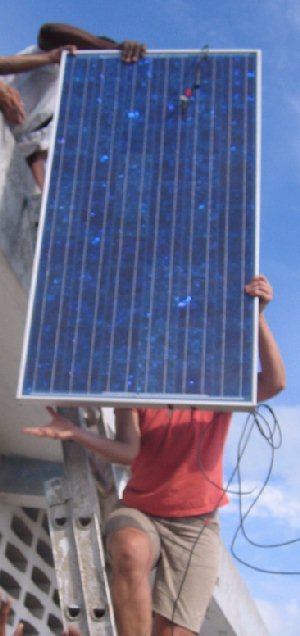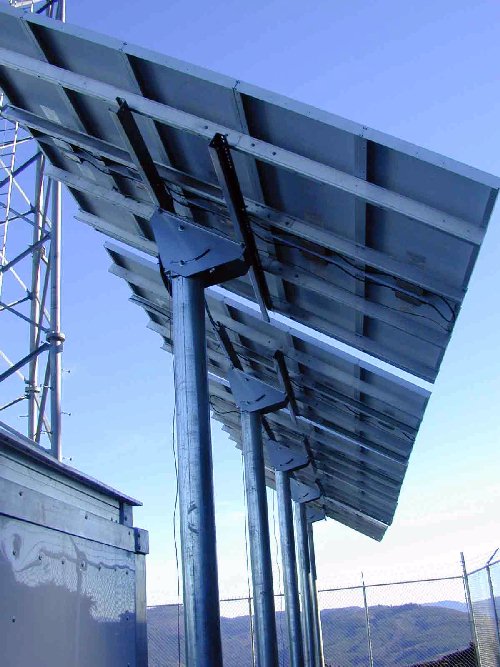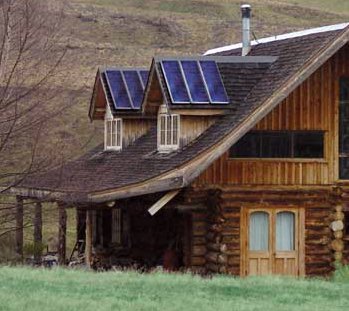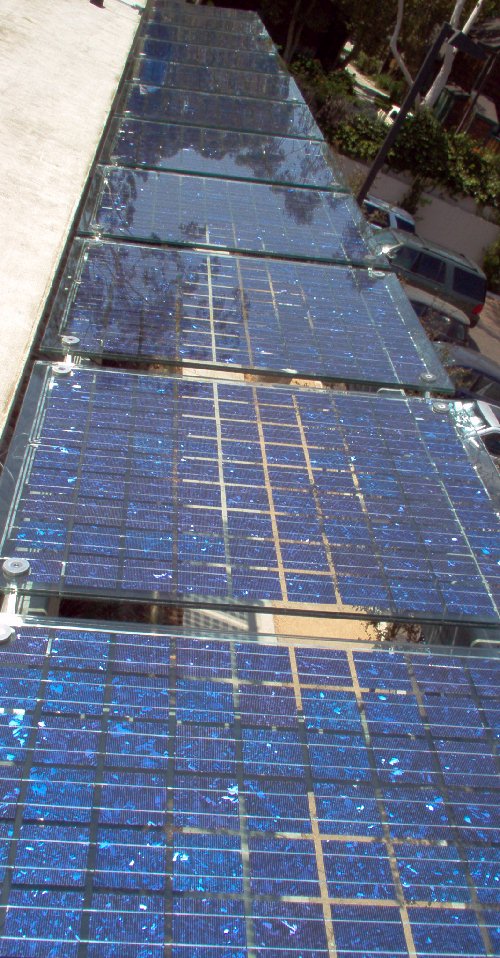|
|
|||||||||||||||||||||||||||||||
|
The Solar Powered Myth
Urban Myths & Solar PowerBy Charles Moffat - December 2007. Two and a half years ago I wrote an article about how there are some very common misconceptions about solar power (and wind power), which included the following: It is an often held misconception that solar power is: #1. Too expensive. #2. Won't provide enough power for large appliances. #3. Won't work during the winter. #4. Only provides power when it is sunny/windy. #5. Too difficult to install. #6. Only last 5 years. #7. Unreliable. #8. Useless at night. #9. Inefficient. #10. Not worth it/not profitable. These ideas are all actually quite false. They are urban myths. But little did I know that article I wrote two years ago would become quite popular (it was getting about 1500 hits per month), but sadly after two years some of the pricing information in that article has changed and needed to be updated. I also think it is important to add an explanation as to what Watt power actually is. Watts are measured in seconds. 1 Watt is equal to one joule of energy per second. 1 Joule equals the amount of energy required to lift a small apple (102 grams) one meter against Earth's gravity. So 60 Joules per second is the amount of energy needed to lift 60 apples 1 meter every second. Large power usage is usually measured in kWh (kilo-watt hours). A single 60 Watt lightbulb is using 60 Joules/second, 216,000 Joules per hour. Switching to a low energy light bulb that uses only 20 Watts starts to make a lot of sense doesn't it? As does saving power overall. A key feature of living in a house powered by solar (and/or wind) power is conserving the amount of energy you use. If you're wasteful you're going to need more than a few solar panels to keep up with your energy usage.
STEP ONE: DETERMINE HOW MUCH ENERGY YOU NEED. Stop and actually read your monthly electricity bills sometime. How many kWh are you using? It should say how much on the bills. Compare bills from last winter and last summer. Were you using electricity to heat or cool your home? If you are running your air conditioner a lot in the summer you might have a fairly huge bill. STEP TWO: DO YOUR RESEARCH. How many solar panels (and/or windmills) do you think you would need to keep up with your daily kWh usage? How much battery supply do you want? You will likely want at least 2 days worth in the event of extreme cloudiness. Hint: Count how many appliances you have on constantly, how many Watts they use when operating and add extra for using items you don't use constantly. That should help determine how many Watts you need at any given moment. STEP THREE: CUT BACK ON YOUR USAGE. Before you go out and purchase solar panels/etc. try and cut back on how much you use first. If you're running extra fridges, freezers, electronic equipment and lights that don't need to be on all day you are wasting a lot of energy. For example, if you're not using it your computer should be turned off. Even if its not being used it is still using about 90 Watts per second, and 180 Watts if the monitor is still turned on (regardless of whether you have a screensaver). It is an urban myth that turning your computer off and on wastes more energy. Since 1992 all computers sold in North America have had to be certified by Energy Saver, which means they use no extra energy when you turn them on than during their regular use. Your Television is another example. Despite the blank screen it is actually on. (Try listening to its buzzing sound in the dead of night sometime.) The reason is because it is using about 10 to 20 Watts to keep the screen "warmed up" so that when you turn on your TV it will be ready to go. Older televisions built in the 1970s/etc didn't have this function and usually took a couple seconds to warm up, with the image appearing quite small as a dot in the middle of the screen and slowly getting bigger. So even though you're not using it your Tv is actually wasting energy so you don't have to wait for the screen a couple seconds.
STEP FOUR: SHOP AROUND. Right: A house with six 120 Watt solar panels from the hardware store Canadian Tire. Don't buy your solar panels at the first place you find. Look around and compare prices for the panels, the batteries and installation. If you still can't figure out how the VCR works you might have to hire someone to install everything for you, which can be costly. Pay attention to how many Watts/dollar you are paying for. An 120 Watt solar panel from Canadian Tire (currently priced at $1099.99) is approx. $9.17 per Watt of power, and is enough power for two 60 Watt lightbulbs or a microwave. An 80 Watt solar panel also from Canadian Tire (currently priced at $749.99) is approx. $9.38 per Watt, so bigger is certainly better in this case and you're going to want your money's worth if you're buying somewhere between 3 to 9 of them (depending on your needs). NOTE 1: Canadian Tire occasionally has these solar panels on sale, so if you wait and keep your eye on their weekly fliers you can get a much better price. NOTE 2: Depending on the current value of the Canadian dollar you might get better bang for your buck by shopping in the United States. If we use the house to the right as an example six solar panels producing 720 Watts of power per second (during peak sunlight times) would cost about $6600 and would be more than enough for their power supply. There are about 4 hours of peak sunlight per day, but don't let that fool you. Solar panels still continue working even at night soaking up minute amounts of energy from starlight (or if you're in the city from the constant glow of street lights), even in the winter, whenever. (There is a lot of people out there who believe that solar panels cease working completely at night.) Solar power and wind power is actually relatively cheap compared to other energy sources, but require more effort to install. One of the expensive things is the battery system (Canadian Tire also sells these). Smaller units are ideal for cottages by the lake and can charge cell-phones, laptop batteries and even power a small microwave. Larger solar panels are used to provide ample supply for even large homes. Two to three large solar panels plus a battery system will cost a person roughly $2500 to $3500 CDN, will provide most all their energy needs, and will feed surplus electricity back into the grid. Years ago Ontario announced a plan to pay 6 cents per kWh to people who produce electricity. They currently sell it at the same rate, but with one major flaw: It costs the Ontario government 9 cents per kWh just to make it. So for every kWh Ontario uses the government ends up paying 3 cents (which we pay in taxes eventually). windmills are cheaper than solar and provide a similar level of energy. Some people even build their own because the motor parts required for a windmill cost less than $15 CDN. Homemade windmills don't provide the same amount of energy as a windmill that you might buy from Canadian Tire, but the solution to this is easy: Build two or more windmills and/or have solar panels too. If you can climb on to your roof and nail a few nails, you can install solar panels, or hire someone else to install it for you. Modern solar panels are heavy-duty, reliable and come with 25 (sometimes 30) year warranties. The myth that solar panels don't work in the winter or a northern (Canadian) climate is completely false. The fact is that solar panels actually work even better during the winter, because of the huge temperature change between night and day. It doesn't even need to be sunny. Solar panels use the changes in air temperature to provide electricity. The more dramatic the temperature change the more energy produced. Thanks to the temperature changes at night solar panels still provide a trickle of energy during the wee hours of the morning, combined with a battery system that hooks into your fuse box, it provides electricity at all times of the day and night. Some people install both windmills and solar panels, wanting to have extra power in case they ever need a boost of energy.
Likewise some people invest and make some extra money off of their leftover energy going back into the grid. Depending on how sunny/windy it is you will likely have a tidy sum left over to brag about. So depending on how many solar panels you have it can actually be profitable. You could turn all your appliances but your fridge and freezer off for two weeks, go on a trip to Florida and see how much cash you earned while you were gone. Even if you're not making money off of them they will still save you money over the long-term. In the event of a black-out or brown-out, your home will remain unaffected, with a battery supply and a constant supply of wind and/or solar power to keep the battery system full. For years, people have been using solar/wind power in remote regions where there is no electricity grid. It would cost them tens of thousands of dollars just to have hydro poles built out to such remote spots. Especially new home owners who have built a house farther away from the road/electricity grid. It would cost them anywhere from $3000 to $20,000 to have hydro poles extended down that long driveway to their home. The electricity company does not pay for pole installation. You do. These days, many new home owners are saving that money and instead investing $3000 (or more) in solar panels/windmills and a battery system that will provide more than enough electricity for their dream home. With rising electrical costs it is the smart thing to do. In the case of some adventuresome young couples, the thing to do is to buy older cottages, fix them up, renovate them, add solar panels/etc, and then sell the place for a handsome profit. In North America roughly 30% of all of our electricity comes from coal-fired electrical plants. Another 50% comes from nuclear plants, and the final 20% is hydro-electric dams, solar panels and windmills. Despite the rising cost of coal it is still one of the cheaper options, but it comes with a steep environmental price-tag: Approximately 25% of greenhouse gases comes from coal electricity. Thus in the future, if we are going to get away from coal energy, most of our electricity is going to have to come from a combination of nuclear power or renewable power sources such as solar, wind or hydro. Canada used to be a leader in solar power technology, but during recent years Japan, China and the United States have become huge producers. Japan currently leads the group, by mass-producing cheap, efficient solar-panels on a massive scale. China is expected to pass Japan as a global producer of soal panels before 2010 and will start to flood the market with cheap solar panels. Indeed, they already are flooding the market. Twelve years ago a solar panel system, like the ones I mentioned above, would have cost a person about $15,000 to $30,000 to provide their home with an abundancy of electricity. These days a person can get the same deal with solar panels for about $3000. Now obviously this isn't going to help people who live in apartment buildings (many apartments have utilities included), but there is nothing to stop the apartment building's owner from setting up to 40 solar-panels on the roof of the apartment building, and thus cutting down on their overall electricity bill. Some farmers seem to be switching crops. Instead of growing wheat or corn, they're installing solar panels and windmills on their barns or even whole fields, creating "wind farms" and "solar farms", cashing in on the 6 cents per kW/hour that Ontario Hydro now pays. Some people are also supporting the idea of a new law that will make all new homes and new buildings required to have solar panels on them. These solar panels could provide extra power to the electrical grid, emergency power for the owners, and decrease the electrity shortage. During the next 13 years our electricity shortage will get worse. By 2020, the amount of electricity we use is expected to double (due to population growth, increased use of computers, electrical heaters, air-conditioners, etc). Solar power is not a myth. It is reality. It is time we faced up to it.
|
|
||||||||||||||||||||||||||||||
|
Website Design + SEO by designSEO.ca ~ Owned + Edited by Suzanne MacNevin | |||||||||||||||||||||||||||||||



